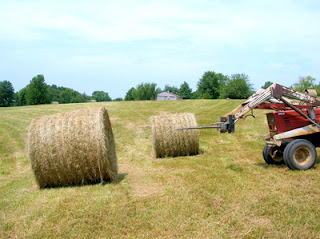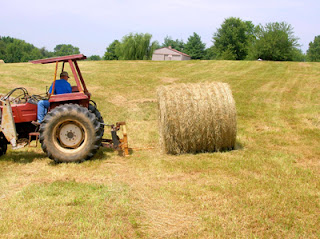Last week we fertilized our hay fields and our pasture. (As with all the farming posts, I use the term “we” loosely. Mostly, I just took pictures.)
The best way to know exactly what type of fertilizer your ground needs is to check a soil sample for the nutrient balance. It has been so unbelievably dry in Indiana this summer that it’s too hard to get a good sample. Soil sampling is done by taking a “core” of dirt – think giant apple corer. Because it has been so dry, the ground is harder than normal, and it’s not easy to get a good core.
Soil testing is actually pretty important. Different crops have different nutritional needs. While we do know basically what these are, they can vary from year to year based on the growing conditions. Soil testing allows a farmer to know exactly what nutrients he needs to add to the soil. This means he’s not paying for something he doesn’t need. There’s no “extra” nutrition going into the soil that won’t be used by the plants and will end up as run off. Also, he’s not missing something which will result in poor crop growth next year.
So, this fall, we fertilized based on what grass hay typically takes out of the soil (the nutrients it needs to grow). Grass takes nutrients out, we put nutrients back in. Everyone’s happy, especially the cows!
The fertilizer is in this big bin. The bin is pulled by a bigger tractor.

We used half the planned amount of fertilizer this fall. In the spring, we will test the soil, and adjust the spring fertilizer mix based on the nutrients that are already present.
(Wondering why we didn’t wait until the spring and do it all then? We grow a “cool weather” grass, which means that it will grow in the late fall and early spring. In the spring, the fields will be too wet to drive a tractor on, but the grass will already be growing. All growing things need the right nutrition! So we gave it a half-dose, and will finish as soon as we can get in the fields in the spring.)
As the tractor drives through the field, the fertilizer is dropped out of the back of the bin, and onto this propeller-type wheel.

We used lime (calcium carbonate) and a mixture of 9% nitrogen, 23% phosphorous, and 30% potassium. (The other 38% is a carrier to dissolve the nutrients in.)
The lime is important to maintain the pH balance of the soil. (Remember high school chemistry?) As crops of any kind grow, they take basic substances out of the soil, and the soil gets acidic over time. Lime is a base (opposite of an acid), and replaces the bases that are incorporated into the plants, so the next round have some bases to work with. (This was done the day before the fertilizer, and I missed my photo op. Don’t worry. It looked the same.)
The wheel spins around and around, and flings the fertilizer out behind the tractor. See the lines of fertilizer that have been flung into the air?

The nitrogen, phosphorous, and potassium are also important nutrients for crops, but different crops need different amounts. For example, corn requires a lot of nitrogen for growth, but soybeans actually produce nitrogen and can replenish nitrogen in the soil. This is why many farmers will rotate soybeans in a field one year, and corn the next.
The cows don’t mind at all. They just keep on eating.

This one was actually more interested in me than in the big tractor rolling around her home.

Seriously. They were more curious about the tractor LEAVING than about it BEING THERE in the first place. These are some pretty laid-back cows!

Come back next week! We’re making sweet sorghum molasses! And there will be more pictures of Buddy the dog…


















